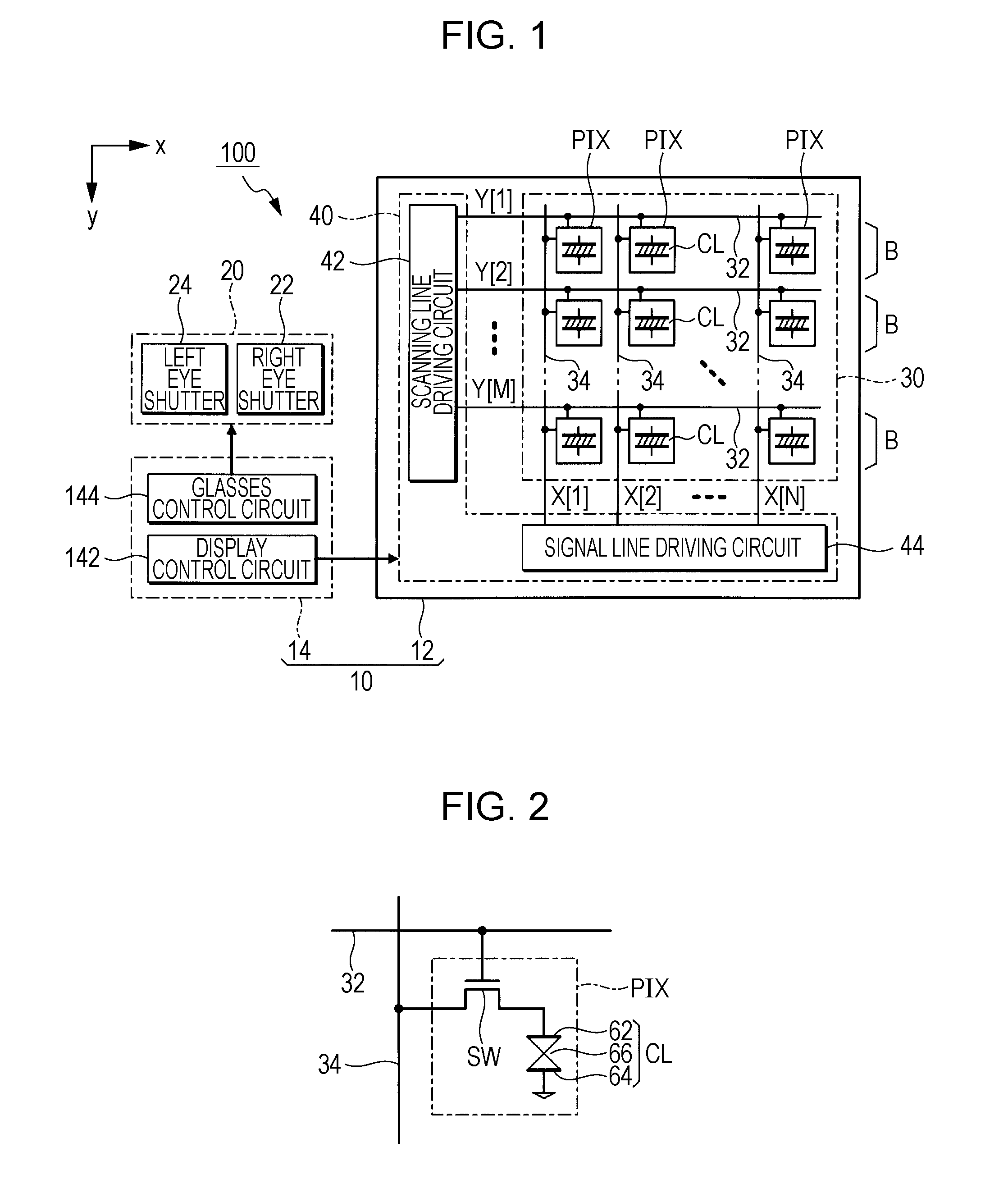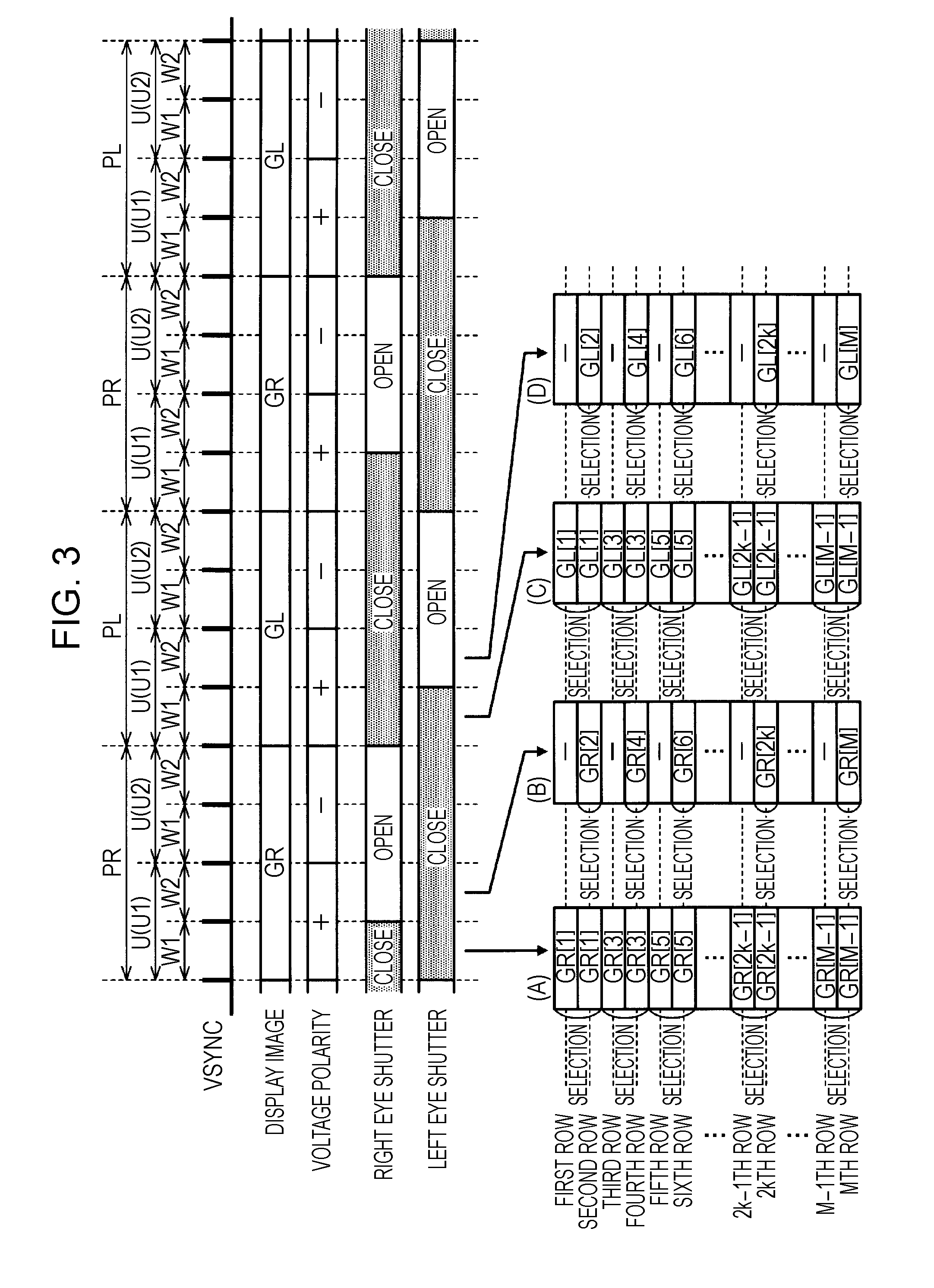Electro-optical device and electronic apparatus
a technology of optical devices and electronic devices, applied in the direction of 3d-image rendering, instruments, computing, etc., can solve the problems of difficult to secure sufficient brightness of display images, user viewing images, and difficulty in detecting stereoscopic effects clearly by viewers, so as to improve the brightness of display images
- Summary
- Abstract
- Description
- Claims
- Application Information
AI Technical Summary
Benefits of technology
Problems solved by technology
Method used
Image
Examples
first embodiment
A: FIRST EMBODIMENT
[0024]FIG. 1 is a block diagram of a stereoscopic display device 100 according to a first embodiment of the invention. The stereoscopic display device 100 is an electronic apparatus which displays a stereoscopic image which allows a viewer to sense a stereoscopic effect using an active-shutter system, and includes an electro-optical device 10 and stereoscopic glasses 20. The electro-optical device 10 alternately displays the right eye image GR and the left eye image GL in a time division manner.
[0025]The stereoscopic glasses 20 are glasses-type equipment worn by the viewer when viewing the stereoscopic image displayed using the electro-optical device 10. The stereoscopic glasses 20 include a right eye shutter 22 which is positioned at the front side of the right eye of the viewer and a left eye shutter 24 which is positioned at the front side of the left eye of the viewer. Each of the right eye shutter 22 and the left eye shutter 24 is controlled to be an open sta...
second embodiment
B: SECOND EMBODIMENT
[0045]The second embodiment of the invention will be described in below. In addition, in each embodiment which is exemplified in below, elements of which operations and functions are the same as those of the first embodiment will be given the same reference numerals and detailed descriptions thereof will be appropriately omitted.
[0046]FIG. 5 is an explanatory diagram of an operation of a scanning line driving circuit 42 according to the second embodiment of the invention. In the first embodiment, the combination of a plurality of the scanning lines 32 (selection unit), which is simultaneously selected in each of the selection periods H(k) of the first writing period W1 was allowed to be common between the unit period U1 and the unit period U2. In the second embodiment, the combination of a plurality of the scanning lines 32, which is selected in the first writing period W1 is different between the unit period U1 and the unit period U2.
[0047]In detail, in the firs...
modified example 1
1. Modified Example 1
[0053]The number of scanning lines 32 which are simultaneously selected in a first writing period W1 (the number of scanning lines 32 which constitute a selection unit) are not limited to two which is exemplified above. When the number of the scanning lines 32 which constitutes the selection unit are generalized to H lines, each unit period U is divided into H writing periods of W1 to WH. In addition, in the initial first writing period W1 among each unit period, the selection unit (H scanning lines 32) is sequentially and simultaneously selected in each of K selection periods H(1) to H(k) (K=M / H). In addition, a potential VG corresponding to the specified gradation of each pixel which corresponds to the specified scanning line among a right eye image GR and left eye image GL is supplied to each pixel circuit PIX in the selection unit. Further, in each writing period Wh (h=2 to H) after a second row in the unit period U, one scanning line 32 of hth row in the se...
PUM
 Login to View More
Login to View More Abstract
Description
Claims
Application Information
 Login to View More
Login to View More - R&D
- Intellectual Property
- Life Sciences
- Materials
- Tech Scout
- Unparalleled Data Quality
- Higher Quality Content
- 60% Fewer Hallucinations
Browse by: Latest US Patents, China's latest patents, Technical Efficacy Thesaurus, Application Domain, Technology Topic, Popular Technical Reports.
© 2025 PatSnap. All rights reserved.Legal|Privacy policy|Modern Slavery Act Transparency Statement|Sitemap|About US| Contact US: help@patsnap.com



